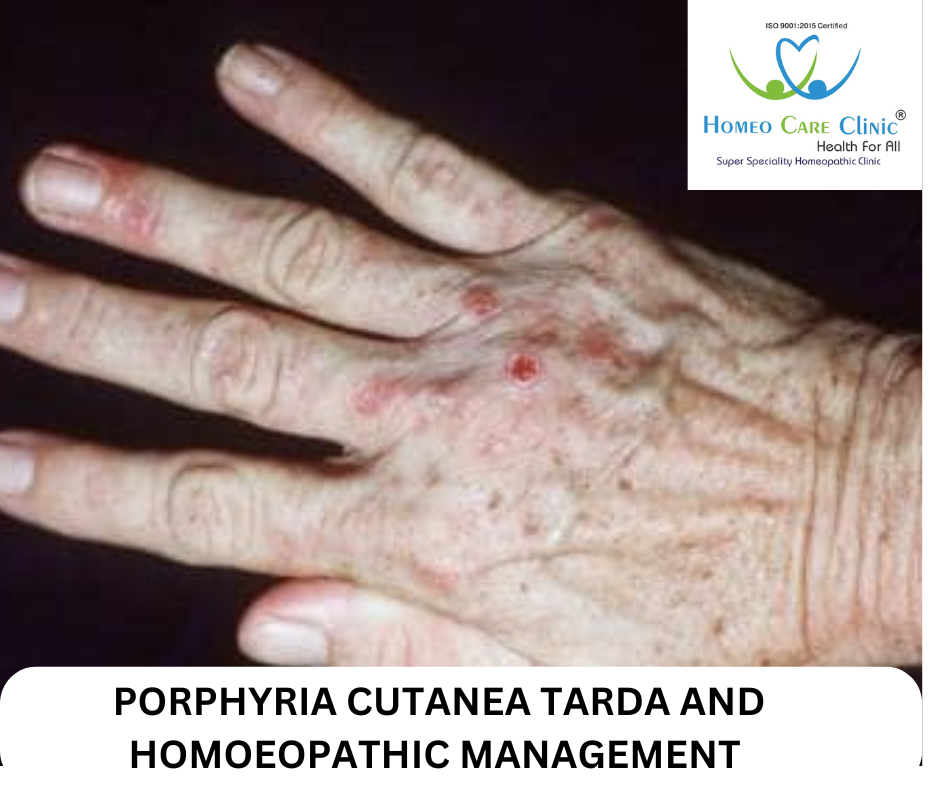PORPHYRIA CUTANEA TARDA DEFICIENCY
Porphyria Cutanea Tarda (PCT) is one of those porphyrias, which affects the skin. A deficiency of the enzyme uroporphyrinogen decarboxylase in the body causes such a kind of disorder. Due to this deficiency, there remains a build-up of porphyrins in the skin. Sometimes it causes blistering and sensitivity of the skin, which further creates cracks mainly on exposed areas to sunlight, like hands and face. The disorder can be induced by alcohol, estrogen use, liver disease, and iron overload among other factors. In addition to medications, such as hydroxychloroquine, the primary treatment of this disease is the avoidance of known triggers and the reduction of iron with phlebotomy.
PORPHYRIA CUTANEA TARDA CAUSES
Causes of Porphyria Cutanea Tarda (PCT):
- Genetic mutations: It has some inherited forms, but most cases are acquired or sporadic.
- Alcoholism: A common precipitant that also worsens the symptoms in chronic individuals.
- Iron overload: Certain conditions such as hemochromatosis often lead to excessive iron, which precipitates PCT.
- Liver disease: Hepatitis C, fatty liver, and several other forms of liver disease can be contributory factors.
- Hormone therapy: Estrogen is another compound whose use as contraceptive therapy or in hormone replacement therapy can provoke PCT.
- Medications: Some drugs, such as anti-malarial drugs can cause this condition
- Smoking: A known risk factor
- Exposure to chemicals: Certain environmental toxins or chemicals would have risk factors
PORPHYRIA CUTANEA TARDA SIGN AND SYMPTOMS
Symptoms and signs of Porphyria Cutanea Tarda (PCT)
- Blistering: Painful blistering with extremely sensitive skin, mainly on sun-exposed parts such as hands face, and forearms
- Skin fragility: The skin becomes thin and tears or distorts easily.
- Hyperpigmentation: Darkening or discoloration of skin.
- Hypertrichosis: Excessive hair growth, mainly on the face, cheeks, and temples
- Scarring: Blisters and skin fragility may bring about permanent scars.
- Sun sensitivity: Pain or discomfort following sun exposure.
- Red or brown urine: This is on account of the accumulation of porphyrins in the body.
These symptoms are usually precipitated or exacerbated by exposure to sunlight, alcohol, or certain medications.
GENERAL APPROACH
Porphyria Cutanea Tarda Management, in general, involves:
- Avoidance of precipitating factors: Severe restrictions or avoidance of alcohol, estrogen, smoking, and sun exposure should be made because they would exacerbate the conditions.
- Sun protection: Many types of sunscreens and protective clothing are available to prevent new tissue damage.
- Phlebotomy: Periodic blood removal to reduce serum iron which can decrease cutaneous porphyrin synthesis
- Low-dose antimalarials: Hydroxychloroquine may also help in the removal of porphyrins that have accumulated.
- Management of underlying conditions: Such as underlying liver diseases, iron overload, and infections like hepatitis C.
- Monitoring for complications: Regular follow-up tests of the liver function and screening of other diseases related to PCT.
- Long-term treatment is given with an aim to avoid exacerbations and any further skin damage.
PORPHYRIA CUTANEA TARDA HOMOEOPATHIC TREATMENT
Porphyria Cutanea Tarda (PCT) remedies are very patient-specific, and remedy selection is generally done by inspecting the symptoms with consideration to the patient’s constitution. However, the following five remedies often come in handy as a rule for use in diseases related to skin sensitiveness, blistering, and liver disease.
- Arsenicum Album: For the burning, blistered skin with symptoms of weakness and restlessness. Useful in conditions where the skin is hypersensitive.
- Sulphur: This is used in many types of skin conditions, including those that itch and inflamed and which flare up at warm temperatures.
- Natrum Muriaticum: This medication can be used on blistering sun, and dryness or cracking of the skin.
- Calcarea Carbonica: This is used when the skin is sensitive, and there’s also an inclination toward liver problem issues or an iron overload condition.
- Lycopodium For liver dysfunction and skin problems, including blistering, with gastrointestinal symptoms or gas.
In conclusion, Homeo Care Clinic offers a holistic approach to treating Porphyria Cutanea Tarda. The remedies mentioned above can treat the underlying causes of the condition and offer relief from the discomfort. However, it is important to consult a qualified homeopathic practitioner for the correct dosage and duration of treatment. Homeo Care Clinic provides comprehensive care for various ailments and offers customized treatment plans based on individual requirements.
To schedule an appointment or learn more about our treatment, please visit our website or give us a call +91 9595211594 Our friendly staff will be happy to assist you. If you’re searching for the best homeopathy doctor, we are here to help.
Follow us on Facebook, Twitter, and Instagram for valuable insights into the world of homeopathy and holistic health.
Facebook – https://www.facebook.com/homeocareclinicpune
Instagram – https://www.instagram.com/homeocareclinic_in
Website – https://www.homeocareclinic.in
Chat with the best homeopathic doctor privately
If you have any queries regarding your disease or any symptoms, Click to send a WhatsApp message. Our best homeopathy dr will be happy to answer you.
Book an Appointment
If you want to visit our clinic, Click to book an appointment.
Online treatment
If you are a busy professional, or you are living in a remote town or city, with no best homeopathic doctor near you, Clickhere to start an online homeopathic treatment with the world’s exclusive, most experienced, and best homeopathic clinic, managed by Dr. Vaseem Choudhary world-renowned homeopathic doctor






